Wandering Around Out There With A Canoe On My Head
Wandering Around Out There With A Canoe On My Head
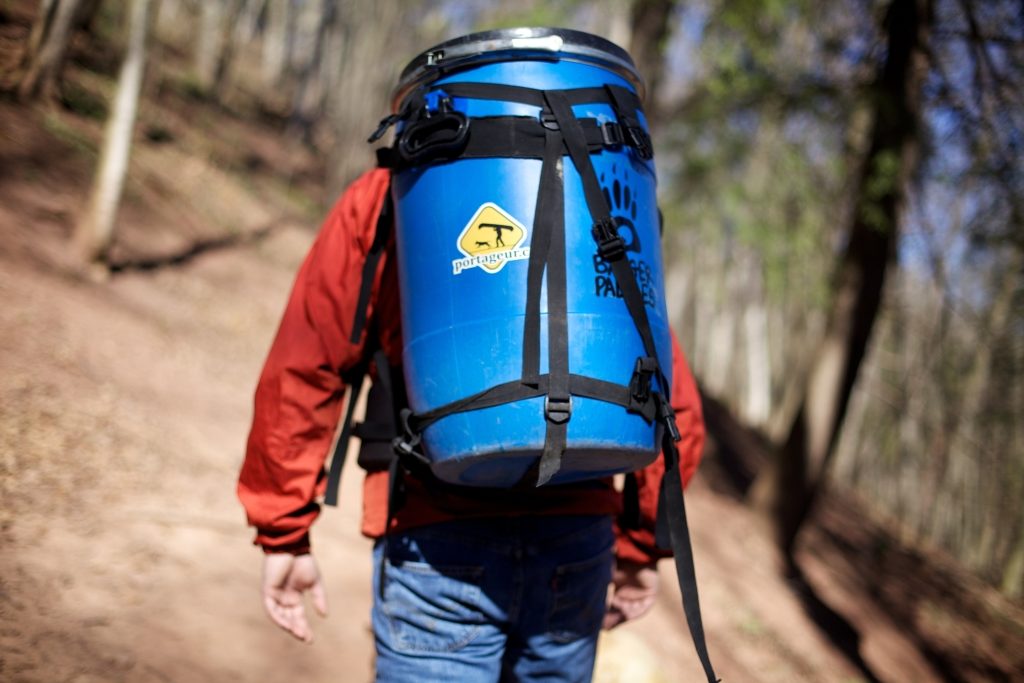
Climbing the portage wearing my barrel pack
Barrel packs are a relatively new phenomenon, compared to canoe packs, wanigans and such, but they’ve become an extremely popular choice among canoe campers and portagers. It’s got to the point where those blue barrels are referred to as “Canoe Barrels”, even though a lot of them may have been used for some other reason before they reached the lakes. Strap one on your back and people know right away that you’re going canoeing, and not backpacking or just off car camping somewhere. (Often people who are unfamiliar with them will call them “Bear Barrels”, implying keeping your food safe from bears. They’re not. See below.)
Why so popular? That’s a good question. I’m glad you asked.
What are they?
Really? You’ve never seen one before? Okay, well Barrel packs are basically a harness that is designed to hold a barrel like you would a backpack. The harnesses have evolved over the years with added features available that make carrying a barrel on your back almost as comfortable as a regular backpack. You can find harnesses with padding for your back and shoulders pads, hip belts as well as load adjuster and sternum straps.
Generally, they’re designed for the 30L or 60L that a lot of food companies use to transport their goods with either a metal sealing ring, tight snap or screw on lid. Someone – I have no idea who – decided these water-tight, food grade barrels would make for great storage in the canoe, and people used to actually carry them without the harness for years. The appeal was that you could find these barrels for practically nothing, getting them from grocery stores or restaurants (hopefully after careful cleaning). Now however, most people it seems prefer to buy a new, never used barrel, specifically designed for canoe camping. What’s the difference between the outdoor store version and the re-purposed food barrels? The new ones usually have a more sturdy metal sealing ring, and often are thicker and durable than a food barrel, which can make them slightly heavier but definitely more expensive. A new 60L barrel can cost you $60-$80, whereas a used barrel can be acquired for $10-$20. If you’re resourceful, or know someone, that can even be free if you’re willing to wash it out yourself.
I used to think people who paid for their barrels were being very silly considering the other options. However I’ve since found out that some barrels have been used to store some strange stuff, and it’s been suggested to me that some have even tested for small amounts of mercury. This is why if you do go with a used one, make sure you know – for sure – what the barrel was used to transport before you got it, and wash it thoroughly.
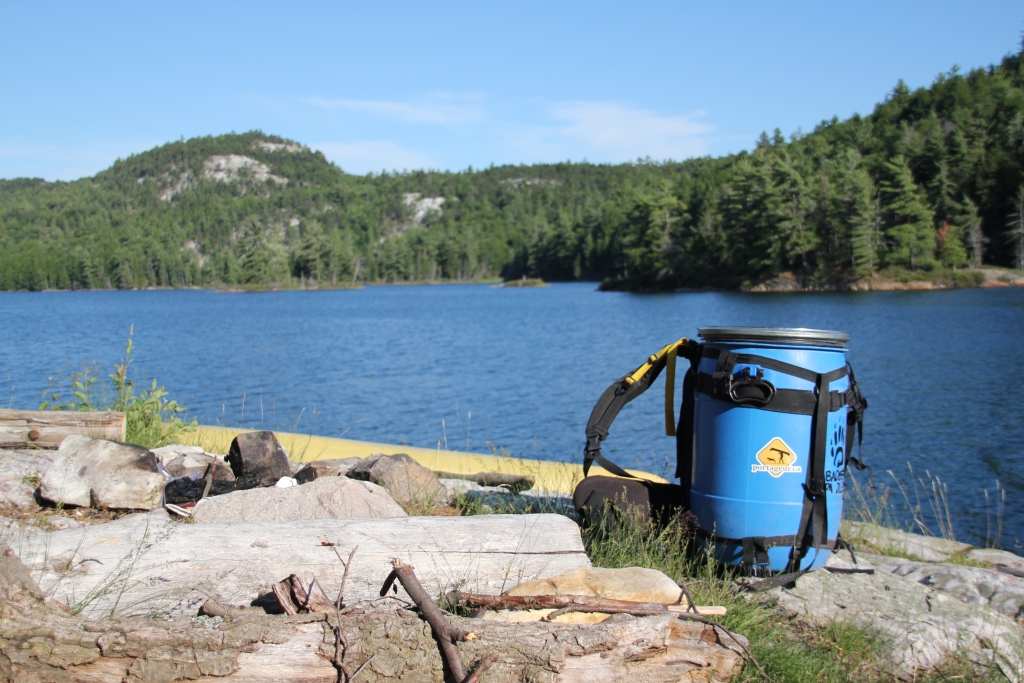
Water Tight
The barrel’s primary advantage is that it’s water tight. Close the lid and nothing’s getting wet. Often, the last thing I do at camp before I go to bed is to throw in all the precious stuff that doesn’t take well to rain – electronics, but more importantly, toilet paper – just in case. Originally, people found that these barrels were great for food storage because they could keep the food away from all the elements, and can even contain heat (in and out) extremely well. I’ve heard of many people storing meat between layers of ice. With the lid on, that ice can stay frozen a surprisingly long time. Remember though, the same principle that keeps water out, also keeps it in.
They also float. This might be the aspect most worth the investment in a barrel pack: In the worst case scenario of a swamping or a full on canoe dump, your pack is safe, and you can concentrate on keeping you and your party safe, not rescuing your stuff. It’ll float and not slowly sink to the bottom of the lake. Sure, it may head down river, but you can always go get it; it’ll be somewhere. I can’t tell you what a great piece-of-mind you have knowing your water or impact sensitive stuff is safe. That’s what you’re really paying for when you buy a barrel pack.

Hard round shell
Another huge appeal is the protection you get with the rigid shell of the barrel. For me, this is important because I am not nice to my gear. (Not fair, really, because my gear is so nice to me.) Mine has seen numerous drops, slammed down countless times, floated down a river, rolled down a hill hitting rocks along the way like a pinball – then floating down a river of course – and has even survived the grueling punishment of airplane luggage. Even with all that, none of my gear has been damaged or fallen out. My current $10 barrel has lasted the last 5 years and shows no sign of breaking down. Where you do want to take care is with the metal sealing ring, as many of the barrels will not close properly without it.
What’s really great, is that even if your barrel gets damaged – the way I used it, I should probably say when it gets damaged – you can simply replace the barrel with a new one, keeping the usually more expensive part, the harness.
Though not a huge deal-breaker, barrels also fit perfectly into the rounded hulls of canoes when placed horizontally. With concentrated weight, positioning them makes a great trimming tool to distribute the canoe’s load. Alternatively, they can also be stored vertically to use up less space. Just make sure to pack them stably.

Compared to a backpack, point-counterpoint
Unfortunately, they’re a little heavier than typical backpacks and the inflexibility of the hard plastic shell makes packing slightly more difficult (i.e. the fabric doesn’t expand or shift). Then again, cleaning is much easier, just turn it over to dump whatever’s in there and spray it with a hose. Unlike a fabric backpack, you’re not going to constantly find little pieces of the all the forests you’ve traveled, nor will you smell them. Barrel packs also won’t have a lot of pockets or pouches or ready-made tie-ons. Then again, depending on the harness you buy, a couple of carbiners or rope will easily tie things to the simple harness structure. Some companies, like Ostrom Outdoors, design specific add-ons like their Barrel pouch. Generally though, you’ll find you can carry a less quantity of bulky items unless you pack well and jam them in real good. Then again, you can really jam things in. It won’t tear or re-shape. With the hard shell, just keep pushing, slam the lid down and you can really stuff your barrel pretty packed. Of course, obviously don’t do this if what your carrying is fragile. (Fun irony would be to crush the very things you’re putting in the barrel for protection.)
Of course the biggest difference is the comfort. Some of the lower end models (polite way of saying cheap) can be night and day compared to a proper hiking backpack. (Though the same is also true for a cheap backpack, but nevertheless…) If you can do it, put the money into a comfortable, well made harness. It’ll be worth it in the long run. Not that any backpack isn’t cumbersome, but the barrel pack does tend to extend further behind you, making for some inadvertent, 3-stooge-esque bumping into things when travelling in closer spaces.
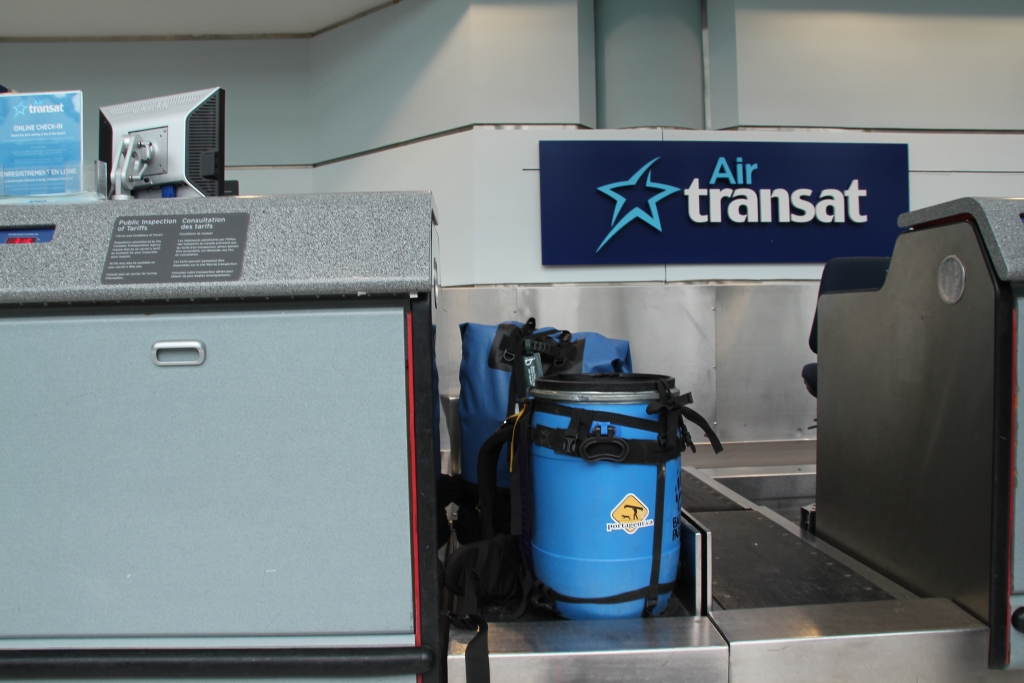
Secondary Purpose
Then again, barrels can also double as other items to varying degrees of success. It can be a camp chair, though the rounded bottom of most make it a bit unstable. With a big enough flat lid, they also make great tables for dining or playing cards. It’s a great step-stool, to reach high places like when tying up a tarp – but learn from my fail here: If your barrel has a rounded bottom, they’re not too stable on rough ground. Turn them upside down because often the lid is more flat. Either way they’re quite slippery when wet. You know what, nevermind, don’t do that. It hurts… I mean, it could hurt when you fall. Not that that’s ever happened to me. And it certainly hasn’t happened twice. Some other uses:

Hard candy shell
Okay, now this is serious: Many people have the mistaken belief that the plastic barrel is critter proof. Depending on the fabric of your backpack, barrels might make gnawing into it a bit more of a challenge for the smaller critters, and you could argue that because they are sealed they would give off less scent to attract said critters – though not if you’re using it as a dining table, as that would have the opposite effect. This is why it’s super important to wash your used barrel to remove any and all scents from whatever food it was used to carry (and so another advantage to buying a new barrel.) So I’d say yes, they’re better for the smaller animals, so long as they’re not tempted into putting in the effort. I have heard stories, though never experienced anything like this myself, of raccoons popping off the lids when they’re not locked.
As for bears, they can and do get into the standard blue barrel. Most parks now showcase that by having an example in the office of what a bear has done to them. These and these are real bear resistant barrels (note that they avoid the term “proof”). In fact, park staff tell me that in popular areas, bears and other food mooches are now associating any blue barrel as a food source. A funny conversation I had once involved someone suggesting that the standard blue barrel could still be considered bear resistant, in that they would be harder, and so take longer to get into than a regular back pack. Sure, you could argue that, I suppose, but what does that mean exactly? What are you going to do, exactly, with that extra time it take the bear to get into your barrel? Sure, I suppose it might give some people the chance to scare it off. But then again, if that doesn’t work it means you’re not only dealing with a bear but a frustrated, hungry bear. Ever get mad at food packaging that just won’t open? Do you remember those pudding tins when the little tab came off? We all had a good laugh at some of these scenarios, and as you can imagine it was a pretty fun conversation.
My point is, don’t think the barrel will make your food safe without taking the same precautions you should normally. All said, hanging it up a tree is your best defense against furry food thieves.
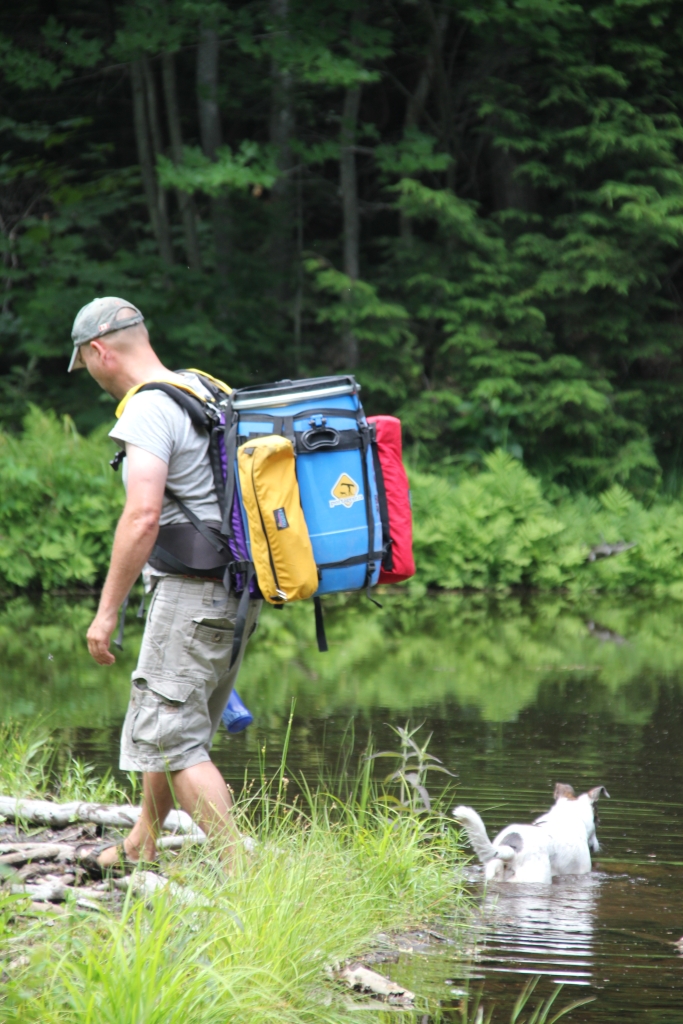
Final Word
When you’re in a group, I usually recommend taking advantage of different types of packs. Think of it this way: Every job has its tool. This means I definitely suggest having at least one barrel pack along if you don’t normally. Conversely, I’d also recommend not going out exclusively with barrel packs if you can. Either way, you can store everyone’s fragile or water-sensitive items in the barrel, or to keep the whole group’s food preserved better, then use the other packs features to store all the other gear. I’d also avoid the 30L model, unless used as a secondary pack, as it seems like a waste of a back that could have been carrying more gear.
Everyone has their own carrying preferences, and will like one pack over another for whatever reason. If you don’t use a barrel harness, I’d recommend trying one to see how you like it. There are several styles and at least one might be appealing to you. If you get a chance, borrow a friends and try it for a whole trip. If you’re like me, you’ll find that the many advantages outweigh (as it were) the few disadvantages.
So what do you think? Have you tried one, and if so, do you prefer them over backpacks?
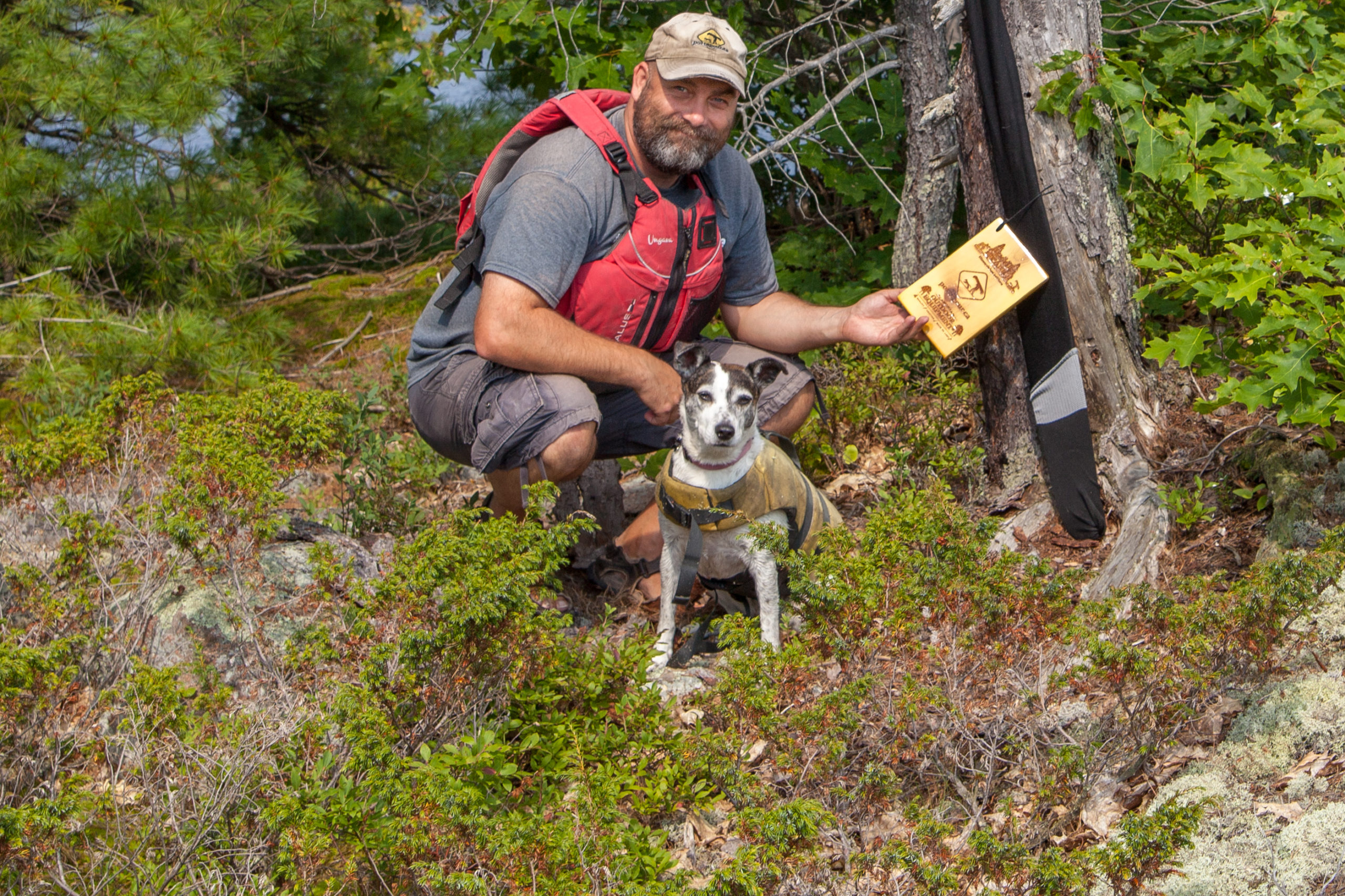
Session expired
Please log in again. The login page will open in a new tab. After logging in you can close it and return to this page.
Good article, my son-in-law and fellow canoer, sent it to me in response to an email I sent wherein I said I was about to make a wanagin/chuck box.
This is a dandy idea, and I am going to suggest that he make a barrel pack, it wil be a great place to keep things we don’t want wet. (last year on a canoe moose hunt we used plastic bins for wanagins, there was no portaging and they fit pretty nice into the bottom of the canoes, however it rained hard and blew a bit, so that most of the lids leaked, even though they were sealed with duct tape.
I am still going to make the wanagin/chuck box though, for the convience of having everything sorted out and having a work space for cooking.
I am the cook, so this matters to me.
We have a fool proof anti-bear system. We are in Northern Onario, not in parks, so one of the party always carries a single shot shotgun. This converts them from looking for food to becoming food!
Thanks Charlie. I’ve never used a Wanigan on a longer trip because I’ve always had (better) alternatives available. However, I’ve heard of a few day courses where you can make yourself one and am still considering doing this and trying it out for the experience. You’re right, they certainly would make great kitchen spaces.
Very informative article. It’s been 18 years since I last went wilderness canoeing. Things have changed and not.
I will be looking for a barrel system.
Thanks.
Hope it works out for you! Unfortunately Ostrohm doesn’t make them any more. I haven’t tried these out on the trail just yet, but Northwater has a new barrel pack available – http://northwater.com/collections/canoe-accessories/products/quick-haul-barrel-harness